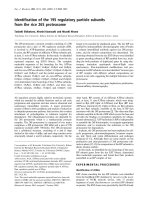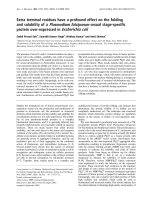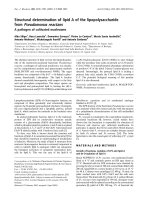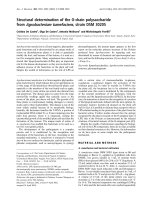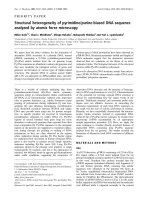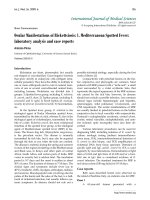Báo cáo y học: "Nucleolar localization of influenza A NS1: striking differences between mammalian and avian cells" pot
Bạn đang xem bản rút gọn của tài liệu. Xem và tải ngay bản đầy đủ của tài liệu tại đây (4.39 MB, 5 trang )
SHOR T REPOR T Open Access
Nucleolar localization of influenza A NS1: striking
differences between mammalian and avian cells
Romain Volmer
1,2*
, Beryl Mazel-Sanchez
1,2,3
, Christelle Volmer
1,2
, Sébastien M Soubies
1,2
, Jean-Luc Guérin
1,2
Abstract
In mammalian cells, nucleolar localization of influenza A NS1 requires the presence of a C-terminal nucleolar locali-
zation signal. This nucleolar localization signal is present only in certain strains of influenza A viruses. Therefore,
only certain NS1 accumulate in the nucleolus of mammalian cells. In contrast, we show that all NS1 tested in this
study accumulated in the nucleolus of avian cells even in the absence of the above described C-terminal nucleolar
localization signal. Thus, nucleolar localization of NS1 in avian cells appears to rely on a different nucleolar localiza-
tion signal that is more conserved among influenza virus strains.
Findings
The nucleolus is a h ighly dynamic multifunctional sub-
nuclear compartment [1]. It is the site of ribosomal
RNA synthesis and ribosomal subunits assembly. In
addition, the n ucleolus is increasingly recognized as a
critical regulator of many other cellular functions,
including the regulation of mitosis, cell growth and
response to stress [1-3]. The nucleolus is also emerging
as an important target of various viral proteins [4]. Viral
proteins targeting the nucleolus are for example impli-
cated in the regulation of apoptosis, as shown with
West Nile virus capsid protein, and in the regulation of
viral mRNA export, as shown with human immunodefi-
ciency virus Rev protein and with herpesvirus saimiri
ORF57 protein [5-7]. However, for most viruses, conse-
quences of viral protein localization in the nucleolus
remain largely unknown [3,4].
The non-structural 1 (NS1) protein of influenza A
viruses NS1 is a multifunctional protein, known to inter-
act with and modify the function of many cellular pro-
teins, thereby creating a cellular environment favouring
virus replication [8]. Recently, a nucleolar localization
signal (NoLS) has been identified in NS1 [9]. This NoLS
targets NS1 to the nucleolus of mammalian cells. Pre-
sently, the role of the nucleolar localization of NS1 in
the viral cycle is unknown. One can speculate that NS1
proteins targeting the nucleolus of mammalian cells
could modify the functions of nucleolar proteins. The
mammalian NoLS of NS1 consists of a stretch of
C-terminal basic amino acids that are present only in
certain strains of influenza A viruses [9]. Thus, only cer-
tain NS1 proteins accumulate in the nucleo lus of mam-
malian cells. Whether NS1 proteins accumulate in the
nucleolus of avian cells is currently unknown.
In this study, we compared the nucleolar localization
of NS1 of different influenza virus strains in mammalian
and avian cells using immunocytochemistry and confo-
cal microscopy. Experiments were done in human A549
alveolar epithelial cells and in primary embryonic fibro-
blasts used between passages 2 and 6, cultured from 11
days old B alb/c mouse ( Mus musculus) embryos, from
14 days old Pekin duck (Anas platyrhynchos)embryos
or from 12 days old chicken (Gallus gallus)embryos.
Cells were infected at a multiplicity of infection (MOI)
of 3 plaque forming units (pfu) per cell (MOI = 3) with
the human influenza A/Udorn/72(H3N2) strain (desig-
nated Udorn), the human laboratory adapted influenza
A/PR/8/34(H1N1) strain (designated PR8), the avian
influenza A/Turkey/Italy/977/V99(H7N1) strain (desig-
nated 977) or the a vian influenza A/Turkey/Italy/4426/
00(H7N1) strain (designated 4426). At 3, 4, 6, 8 and 12
hours post-infection (hpi), cells were fixed with 4% P ar-
aformaldehyde, permeabilized with Phosphate Buffered
Saline (PBS) 0.5% Triton X-100 and incubated for one
hour in PBS 0.1% Triton X-100 and 2% Bovine Serum
Albumin. Antibody incubation was performed overnight
at 4°C.
The C-terminal sequence of Udorn NS1 protein con-
tains t he basic amino acids identified by Melen et al. as
* Correspondence:
1
INRA, UMR 1225, Ecole nationale vétérinaire de Toulouse, F-31076 Toulouse,
France
Volmer et al . Virology Journal 2010, 7:63
/>© 2010 Volmer et al; licensee BioMed Central Ltd. This is an Open Ac cess a rticle distributed under the terms of the Creative Commons
Attribution License (http://crea tivecommons.org/licenses/by/2.0), which permits unrestricted use, distribution, and reproduction in
any medium, provided the original work is properly cited.
defining the mammalian NoLS (underlined in Figure 1),
whereas the other NS1 proteins lack one or more of
these basic amino acids [9]. Consequently, only the N S1
of Udorn accumulated in the nucleolus of primary
mouse embryonic fibroblasts (MEF) and of A549 human
respiratory cells (Figure 1). NS1 proteins of the other
viruses tested did not accumulate in the nucleolus of
mammalian cells irrespective of the time post-infection
(Figure 1). By contrast, the NS1 of all viruses used in
this study accumulated in the nucleolus of primary duck
embryonic fibroblasts (DEF) and primary chicken
embryonic fibroblasts (CEF) at 4 hpi (Figure 1). Thus,
all NS1 proteins tested have an amino acid sequence
forming a functional NoLS in avian cells. In addition,
our results show th at the amino acids required to target
NS1tothenucleolusofaviancellsdifferfromthe
amino acids required to target NS1 to the nucleolus of
mammalian cells.
Then, we verified t hat NS1 targets the nucleolus in
vivo. We infected two-week old Pekin ducks ora lly with
Figure 1 Subcellular localization of NS1 in infected cells. Human A549 alveolar epithelial cel ls, mouse e mbryonic fibroblasts (MEF), duck
embryonic fibroblasts (DEF) and chicken embryonic fibroblasts (CEF) were infected at a MOI = 3 with different strains of influenza virus. The cells
were fixed, stained with a rabbit anti-NS1 polyclonal antibody and a secondary FITC-labelled anti-rabbit antibody and imaged with a confocal
microscope. Shown are representative pictures obtained from cells fixed 4 hpi. The C-terminal amino acid sequence of NS1 is indicated under
the name of each viral strain. The basic amino acids identified by Melen et al. as defining the mammalian NoLS are present in the NS1 of Udorn
and are underlined.
Volmer et al . Virology Journal 2010, 7:63
/>Page 2 of 5
10
7
pfu of the 977 virus. Previous experiments per-
formed with this virus had shown that the ileum and
the colon were the major sites of virus replication (our
unpublished observation). Immunohistochemical stain-
ing of 3 μm paraffin embedded ileal sections with a rab-
bit polyclonal anti-NS1 antibody (Figure 2) revealed
the presence of viral antigens in enterocytes 6 days
post-infection. Anti-NS1 antibodies detected with a per-
oxidase-coupled secondary antibody revealed with dia-
minobenzidine stained the cytoplasm and subnuclear
structures, corresponding to nucleoli (Figure 2). Thus,
the subcellular localization of NS1 in vitro is consistent
with its nucleolar localization in duck intestinal epithe-
lial cells.
Viral infections can lead to changes in the nucleolar
morphology, likely caused by virus-induced disruption
of nucleolar functions, as shown for the infecti ous bron-
chitis coronavirus and for the herpes simplex virus 1
[10,11]. We therefore analyzed whether nucleolar locali-
zation of NS1 modified the expression pattern of
nucleophosmin (NPM), a nucleolar protein that localizes
to the granular centre of the nucleolus [3]. We per-
formed a time course analysis of the intracellular locali-
zation of NS1 a nd NPM (Figure 3) in DEF infected at a
MOI = 3 with either the 977 or the Udorn viruses. In
DEF, NS1 of both viruses colocalized with NPM (Figure
3). Nucleolar localization of NS1 was visible 3 hpi and
was maximal between 4 and 6 hpi (Figure 3). Nucleolar
accumulation declined starting 6 hpi. The intensity of
nucleolar NS1 staining eventually became indistinguish-
able from the nucleoplasmic NS1 staining between 8
and 12 hpi. In addition, we detected bright cytoplasmic
foci of NS1 in D EF infected with the 977 virus (Figure
1&3). T hese foci were remi niscent of previously
described virus-induced cytoplasmic inclusions that
remain of uncertain identity [12]. No apparent change
in the pattern of NPM expression was observed in DEF
infected with the 977 virus. By contrast, starting 12 hpi,
faint NPM staining could be detected in the nucleo-
plas m of Udorn infected cells, suggest ing that a fraction
of NPM is displaced fr om the nucleolus to the nucleo-
plasm following infection. Increased levels of NPM in
the n ucleoplasm, as well as ring-like NPM staining pat-
tern were detected in about 50% of Udorn infected cells
at 12 hpi. Interestingly, changes in NPM staining pattern
has also been observed following infection with the cor-
onavirus infectious bronchitis virus whose nucleocapsid
protein targets the nucleolus [10]. In DEF infected with
Udorn, changes in the nucleolar morphology appeared
between 8 and 12 hpi, corresponding to a stage in the
virus life cycle where cytopathic effects, such as mem-
brane blebbing became visible (date not shown). Thus,
rather than being due to a direct effect of NS1 on
nucleolar functions, disruption of the nucleolar mor-
phology in influenza virus infected cells could result
from virus induced intracellular stress. Alternatively,
Figure 2 Subcellular localization of NS1 in duck ileal epithelial cells in vivo. A) Ileum collected 6 days post-infection from a Pekin duck
infected orally with 10
7
pfu of the 977 virus, formalin fixed, sectioned at 3 μm. Immunohistochemical anti-NS1 staining detected with a
peroxidase-coupled secondary antibody revealed with diaminobenzidine, hematoxylin counterstained. Arrowheads point to NS1 positive
enterocytes. Scale bar = 20 μm. B) Magnification of the dotted region shown in panel A. NS1 staining is detected in the cytoplasm and in
subnuclear structures, corresponding to nucleoli. Scale bar = 10 μm.
Volmer et al . Virology Journal 2010, 7:63
/>Page 3 of 5
displacement of NPM from the nucleolus to the nucleo-
plasm could be due to an interaction of the viral ribonu-
cleoprotein complex with NPM, as shown in MDCK
cells infected with the influenza A/WSN/33 virus [13].
Presently the role of the nucleolar localization of NS1
in influenza virus cycle is unknown. In mammalian cells,
nucleolar accumulation of NS1 occurs only with certain
strains of influenza A viruses. As the NS1 of all viruses
studied here targeted the nucleolus of avian cell, we
speculate that the nucleolar localization of NS1 could be
an important step during the viral cycle in avian cells.
Whether, nucleolar localization of NS1 contributes to
virulence is currently unknown. Valuable information
would certainly be obtained by studying the phenotype
of a reverse genetics engineered virus lacking a func-
tional NoLS. In order to perform such studies in avian
cell s, the avian NoLS needs to be identified. Our results
show that the avian NoLS relies on an amino acid
Figure 3 Time course analysis of NS1 and NPM staining in DEF infected with the 977 or the Udorn virus. DEF were infected at a MOI =
3 with the 977 or the Udorn virus and fixed at the indicated time post-infection. Cells were stained with a rabbit anti-NS1 polyclonal antibody
and a mouse anti-NPM monoclonal antibody, revealed with a secondary FITC-labelled anti-rabbit antibody and a secondary RhodamineX-labelled
anti-mouse antibody. FITC and RhodamineX fluorescences were acquired sequentially on a confocal microscope. Asterisks point to the NPM
staining pattern in non-infected cells. Arrowheads point to virus-induced changes in NPM staining pattern.
Volmer et al . Virology Journal 2010, 7:63
/>Page 4 of 5
sequence that is present in all the influenza virus strains
tested in this study, and thus could be conserved among
most influenza virus strains.
Acknowledgements
We thank I. Capua and W. Dundon (Istituto Zooprofilattico Sperimentale
Delle Venezie, Legnaro, Italy), N. Naffakh (Institut Pasteur, Paris) and R.
Fouchier (Erasmus University, Rotterdam, Netherlands) for the kind gift of
viruses, D. Marc (INRA, Tours, France), J. Ortin (Centro Nacional de
Biotecnología, Madrid, Spain) for the kind gift of antibodies.
Author details
1
INRA, UMR 1225, Ecole nationale vétérinaire de Toulouse, F-31076 Toulouse,
France.
2
Université de Toulouse; ENVT; UMR 1225; F-31076 Toulouse, France.
3
Centre for Biomolecular Sciences, School of Biology, University of St.
Andrews, North Haugh, St. Andrews, Fife KY16 9ST, UK.
Authors’ contributions
Conceived and designed the experiments: RV. Performed the experiments:
RV, BMS, CV, SMS. Analyzed the data: RV, BMS, JLG. Wrote the paper: RV,
BMS. All authors read and approved the final manuscript.
Competing interests
The authors declare that they have no competing interests.
Received: 19 November 2009 Accepted: 17 March 2010
Published: 17 March 2010
References
1. Boisvert FM, van Koningsbruggen S, Navascues J, Lamond AI: The
multifunctional nucleolus. Nat Rev Mol Cell Biol 2007, 8:574-585.
2. Mayer C, Grummt I: Cellular stress and nucleolar function. Cell Cycle 2005,
4:1036-1038.
3. Sirri V, Urcuqui-Inchima S, Roussel P, Hernandez-Verdun D: Nucleolus: the
fascinating nuclear body. Histochem Cell Biol 2008, 129:13-31.
4. Hiscox JA: RNA viruses: hijacking the dynamic nucleolus. Nat Rev
Microbiol 2007, 5:119-127.
5. Boyne JR, Whitehouse A: Nucleolar trafficking is essential for nuclear
export of intronless herpesvirus mRNA. Proc Natl Acad Sci USA 2006,
103:15190-15195.
6. Yang MR, Lee SR, Oh W, Lee EW, Yeh JY, Nah JJ, Joo YS, Shin J, Lee HW,
Pyo S, Song J: West Nile virus capsid protein induces p53-mediated
apoptosis via the sequestration of HDM2 to the nucleolus. Cell Microbiol
2008, 10:165-176.
7. Zolotukhin AS, Felber BK: Nucleoporins nup98 and nup214 participate in
nuclear export of human immunodeficiency virus type 1 Rev. J Virol
1999, 73:120-127.
8. Hale BG, Randall RE, Ortin J, Jackson D: The multifunctional NS1 protein of
influenza A viruses. J Gen Virol 2008, 89:2359-2376.
9. Melen K, Kinnunen L, Fagerlund R, Ikonen N, Twu KY, Krug RM, Julkunen I:
Nuclear and nucleolar targeting of influenza A virus NS1 protein: striking
differences between different virus subtypes. J Virol 2007, 81:5995-6006.
10. Dove BK, You JH, Reed ML, Emmett SR, Brooks G, Hiscox JA: Changes in
nucleolar morphology and proteins during infection with the
coronavirus infectious bronchitis virus. Cell Microbiol 2006, 8:1147-1157.
11. Lymberopoulos MH, Pearson A: Involvement of UL24 in herpes-simplex-
virus-1-induced dispersal of nucleolin. Virology 2007, 363:397-409.
12. Petri T, Dimmock NJ: Phosphorylation of influenza virus nucleoprotein in
vivo. J Gen Virol 1981, 57:185-190.
13. Mayer D, Molawi K, Martinez-Sobrido L, Ghanem A, Thomas S, Baginsky S,
Grossmann J, Garcia-Sastre A, Schwemmle M: Identification of cellular
interaction partners of the influenza virus ribonucleoprotein complex
and polymerase complex using proteomic-based approaches. J Proteome
Res 2007, 6:672-682.
doi:10.1186/1743-422X-7-63
Cite this article as: Volmer et al.: Nucleolar localization of influenza A
NS1: striking differences between mammalian and avian cells. Virology
Journal 2010 7:63.
Submit your next manuscript to BioMed Central
and take full advantage of:
• Convenient online submission
• Thorough peer review
• No space constraints or color figure charges
• Immediate publication on acceptance
• Inclusion in PubMed, CAS, Scopus and Google Scholar
• Research which is freely available for redistribution
Submit your manuscript at
www.biomedcentral.com/submit
Volmer et al . Virology Journal 2010, 7:63
/>Page 5 of 5
